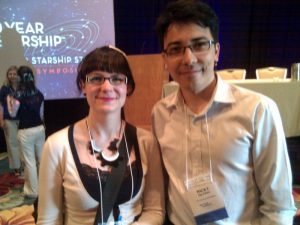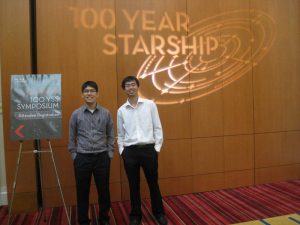Summary for Wednesday/本周三开放日综述 胡介鸣 – BlackBoxlab Alex Cureton-Griffiths – SpaceGAMBIT
Wednesday Meetup – Free – @ XinCheJian – 7-9pm – 12/12/2012
December 12th, 2012 § 0 comments § permalink
Wednesday Meetup – Free – @ XinCheJian – 7-9pm – 26/09/2012
September 26th, 2012 § 0 comments § permalink
本周演讲者介绍
Open Source General Purpose Software Radio Platform
December 3rd, 2011 § 0 comments § permalink
Final 100YSS proposal delivered to DARPA
November 11th, 2011 § 5 comments § permalink
It’s still got warts but I’m personally pretty happy with the results… You can see the PDF here.
40 pages in less than 72 hours is a big achievement and it’s truly been a global effort and a nice example of inter-hackerspaces collaboration. Huei Ming Tan (who did the bulk of the writing!) and Eddie Choo from Ground Up Initiative in Singapore (http://groundupinitiative.org/) with a lot of incredibly valuable and numerous feedback from Paul Szymkowiak and friends from Connected Community Hackerspace (http://hackmelbourne.org) in Australia and Jerry Isdale from Maui Makers (http://mauimakers.com) plus many others leaving comments here and elsewhere.
Thanks in particular to Paul and Jerry who made it possible for the document to go from mediocre to passable!
And a big, big thanks to Justin Myers from HacDC in Washington DC (http://www.hacdc.org/) who hand-delivered the document at the DARPA office in Arlington as you can see in the attachment…
When you think about it, this is hackers from 4.5 countries (China, Singapore, Australia, US and honestly, Maui, Hawaii is in the middle of the Pacific so far away from the continental US) collaborating together. I think whether or not we get the grant (and we should, as I’m convinced Hackerspaces are the only viable option for 100YSS) this is awesome!
Now we have to wait to see who gets selected for the half a million dollars grant… If and when this happens, the initial caretakers will create the 100YSS nonprofit and a charter. Interested Hackerspaces representatives (one per Hackerspace) will be voted in the organization. These representative will then select staff members from candidates for the first 3 months (renewable), gather project proposals and start funding each one by one.
]]>100 Year Starship Study Symposium
October 27th, 2011 § 1 comment § permalink
100 Year Starship Study Symposium in Orlando, Florida October 30th to September 2nd. The goal of the 100 Year Starship Study is to create an organization with a small amount of seed money (one-time half a million dollars US) that can lead the development of an interstellar starship within the next century. At the symposium, I joined Tan Huei Ming and Eddie Cho, both at the National University of Singapore. They had independently submitted a document to the 100 Year Starship Study and I had met them in person while participating in DARPA “The Future of Make” executive panel in Singapore.
Initiated by Mr David L. Neyland (DARPA tactical technology office) and Dr Peter Worden (Director, NASA Ames Research Center). As a major driver of the whole endeavor, Mr Neyland kicked off the symposium and introduced the keynote speaker: Ariel Waldman of spacehack.org with her talk “Hacking Space Exploration”. [caption id="" align="aligncenter" width="300" caption="Ariel Waldman and me"]
 [/caption]
Ariel is a graphic designer that has always been fascinated by space and she talked about how doing something changes how we see something and that we don’t need to be an astronaut to do space stuff… don’t even need to be at NASA to explore stuff! “. We should not let lack of knowledge prevent people to send stuff into space: we need to make technology disruptively accessible. This can be done through competitions and communities such as Google Lunar X Prize, Lockeed Martin’s Aerospace Exploration, university rover challenge, Galaxy Zoo.
There was many talks on many tracks throughout the 3 days of the symposium, all very informative and interesting.
[caption id="attachment_1675" align="aligncenter" width="470" caption="A sample of the talks"]
[/caption]
Ariel is a graphic designer that has always been fascinated by space and she talked about how doing something changes how we see something and that we don’t need to be an astronaut to do space stuff… don’t even need to be at NASA to explore stuff! “. We should not let lack of knowledge prevent people to send stuff into space: we need to make technology disruptively accessible. This can be done through competitions and communities such as Google Lunar X Prize, Lockeed Martin’s Aerospace Exploration, university rover challenge, Galaxy Zoo.
There was many talks on many tracks throughout the 3 days of the symposium, all very informative and interesting.
[caption id="attachment_1675" align="aligncenter" width="470" caption="A sample of the talks"] [/caption]
I tried focusing on those that could help guide our developments in the short-term (next decade):
[/caption]
I tried focusing on those that could help guide our developments in the short-term (next decade):
- “Long-term computing” (Andreus Tziolas, Icarus Interstellar): Autonomous software and decision making processes for Icarus (presenting on behalf Dimos Homatas). Piece of software for a piece of unseen hardware that you’ve never seen before: centennial mission – twice as long as the history of computing itself. How much space is needed for a century mission? How much data will you collect? What about failures during that timespan (rebooting computers once a week)?
- “Big questions in Science-Fiction” (M. O’Keefe): who are we, how did we get here, what are we here for, what’s man’s place in the universe? The vision provided by science-fiction is one where technicians and scientists find answers to these questions. Direct inspirations from science-fiction designs.
- The Interstellar Vision: Principles and Practices (P. Gilster, Tau Zero Foundation): Near-by space missions will lead to an interstellar space mission because we will find those things that threaten Earth. Add the ability to find and nudge out the things that threaten.
- Creating Materials for the Starship (David Weiss, Eck Industries): Sophisticated alloys are the key to the metals we produce today. Transmutation is not as weird as it sound… We do it everyday (heat treatment) changes structure. Bombarding by radiation. High magnetic field processing. How to best spur materials development: challenge Grants, InnoCentive Challenge, X-Prize approach.
- Using video games to help the 100YSS” (Luke Blaize). Check out the Kerbal Space Program game.
- Marketing the Starship (Gordon Gould): Why a starship? Especially given the actual problems… Because we need a long-term goal. Thinks this is mostly a marketing problem: how to get humans excited about it.
- Project Icarus / Project Daedalus: fundamental science achievable in the near future. Making smaller versions of Daedulus (Pathfinder; 1/100th the mass of Daedalus Stage 2). Target speed: 100 au/YR, Isp: 50,000s, Vex: 500km/s).
- Building blocks to building a starship: repurpose “space trash” into new ships – DARPA’s Phoenix project.
- Jefferson Middle school presentation about their own one-month research in 100 YSS: Impressive presentation for a middle school: “Parliamentary democracy is the ideal system”. “People on long flight may go insane”. “Need to convince all religions to support this project”. “If space colonization is possible, communication is quite important”.
- Moon mining robot for the Lunabotics 2011 competition; an X Prize competition turned into a yearly student competition. See the ERAU Daytona Beach Lunabotics Competition 2011 video.
- Virgin Galactic talk (George Whitesides, President & CEO) with Sir Richard Branson doing a pre-recorded video encouraging participatings to the 100 Year Starship.
- ISS life support system (Monsi Roman, NASA): complete analysis of needs and effluents from astronauts.
- Small Body Exploration Technologies as Precursors for Interstellar Robotics (Robert J. Noble, Mark V. Sykes) : Learning how to explore small bodies here as a first step to interstellar flight. Challenges: AI, robotic governance, adapting to the unexpected. Noted the exotic idea of building an “Astrochicken”, a bio-cyber-electro-mechanical probe that can explore space independently.
- Going to Mars as a one way mission (Dirk Schulze-Makuch): Going to Mars as a one way mission (Dirk Schulze-Makuch), as a lifeboat, as a first human colony. Why one way mission? Cost of going one way: 20 billion$USD. Cost of round-trip: 100 billion$. This is due to lift-off fuel when coming back from Mars. He’s Looking for a 9-month study to produce a whitepaper on how to proceed technically and economically – need 80K$ from donors .
Hackerspaces Space Program
August 30th, 2011 § 0 comments § permalink
short document was well-received and we’ve since been invited to both an Asian manufacturing roundtable in Singapore (next week) and to the 100 Years Starship Symposium in Orlando at the end of September. In the meantime, existing efforts continues in various Hackerspaces, such as the Lunar Numbat space program and the Space Program track at Chaos Communication Camp. To get the efforts further organized, it seemed eminently reasonable to establish both a wiki page and a mailing list on hackerspaces.org: Although right now focused on the 100YSS discussion, I think we can use both resources as a focus for any space-related efforts in our respective hackerspaces – if only to catalog and showcase the efforts so far. If you have an interest, I invite you (space geek!) to join the new mailing list and start the discussion.]]>
XinCheJian and the 100 YEAR STARSHIP STUDY
June 4th, 2011 § 3 comments § permalink
REQUEST FOR INFORMATION (RFI) 100 YEAR STARSHIP™ STUDY” The research and work required to build such a starship will itself take decades to answer the challenges of interstellar travel. So the question is: what is the organization best suited to host this research while maximizing the benefits to humanity? It seems obvious that the nascent movement of technology-oriented communities that are hackerspaces is the best way to host that kind of research and to make sure that the positive results of that research is made available to all. This is why, 24 hours before the deadline, we solicited hackerspaces around the world to join in a response to the Request For Information. The result in itself speaks to the power of our global community; in that extremely short laps of time, we were able to write up collaboratively and submit an answer suggesting a Global Hackerspaces Consortium. The document is the result of the joint editing efforts of five different hackerspaces from Melbourne, Shanghai, San Francisco, Brooklyn and Maui. If we are asked to submit a proposal to a Request For Proposal, we expect to have a lot more hackerspaces join us in taking up this challenge. Although our participation to this is a long shot, this is clearly a demonstration that as the hackerspace movement grows, we can expect our scope and impact to increase. Read our answer to the RFI here: Global Hackerspaces Consortium and the 100 YEAR STARSHIP STUDY.]]>
